
St Leonards Church Sandridge
Encyclopedia
St Leonard's Church is the parish church
of Sandridge
, a small village in Hertfordshire
, England.
and the Chancel
is thought to date from 946.
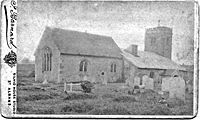 It was no later than 1119 that the church was consecrated and dedicated to St Leonard
It was no later than 1119 that the church was consecrated and dedicated to St Leonard
by Herbert de Losinga
1st Bishop of Norwich
(he died in 1119) and that Sandridge became a parish.
The nave
was enlarged and aisles were added between 1160 and 1180. On either side of the nave are three Norman arches. The church font is also thought to date from Norman times. The early English pointed arch and the tower either built or re-modelled towards the end of the 13th century.
The stone screen was added to the wall between the Nave and the Chancel towards the end of the 14th century. It is richly ornamented on the eastern side but plainer on the west as here there was a carved wooden screen
with Rood Loft and Rood
above and an alter on each side of the archway into the Chancel. The Chancel was re-built and lengthened in 1399 and the squared headed perpendicular windows replaced the narrower Norman windows in the aisles. The south doorway was also built.
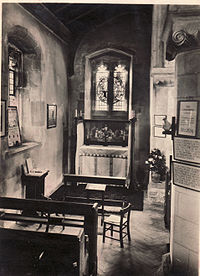 After the dissolution of the monasteries
After the dissolution of the monasteries
many valuable ornaments and fittings of the Church were removed and the church fell into neglect and decay. By 1638 the church was fitted with pews and the arrangement of these has lasted to modern times. A pulpit
was erected on the south side of the nave, the remains of which can be seen in the prayer desks in the sanctuary. The tower collapsed in 1692 or 1693 and the church wardens reported that the rebuilding would cost seven hundred pounds. Nothing was done beyond boarding up the arch in the west end and clearing away some of the rubble.
The clerestory
of the Nave and the roof were in a very bad state in 1710 but where patched up and made to serve until 1786. In 1786 the rotten walls of the clerestory were removed and the roof lowered and flattened out to rest on the Norman arches. Attic windows were put in and the wooden bell turret erected. Between 1836 and 1838 a tower was built. During 1886 - 1887 Mr William White restored the whole church to the state it exists in today. It cost £3800 and re-opened on June 7, 1887. The ring of bells was dedicated on the 11 January 1890.
The organ was given by Mr & Mrs Kinder, Mr & Mrs Marten and Dr Griffith. Before the restoration it stood in the Chancel, then re-built under the Tower and in 1914 enlarged and re-built at the east end of the North Aisle. At the same time the Pulpit was moved to the north side of the Chancel screen and the Choir seated in the Chancel.
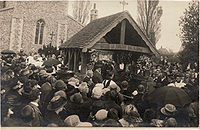
The lesson was Revelation xxxi, 1-7 and read by the Reverend T. W. Lister
The Address was given by the Dean of St Albans the Very Reverend G W Blenkin
At the Lychgate itself the unveiling was by Colonel Henry Page Croft MP.
The final hymn sung by the children
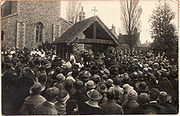
This was followed by the Benediction, then The Last Post a brief silence and the Reveille
and the National Anthem.
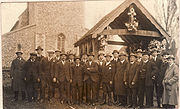
Parish church
A parish church , in Christianity, is the church which acts as the religious centre of a parish, the basic administrative unit of episcopal churches....
of Sandridge
Sandridge
Sandridge is a small village and civil parish between St Albans and Wheathampstead in Hertfordshire, England, United Kingdom.-Early history:...
, a small village in Hertfordshire
Hertfordshire
Hertfordshire is a ceremonial and non-metropolitan county in the East region of England. The county town is Hertford.The county is one of the Home Counties and lies inland, bordered by Greater London , Buckinghamshire , Bedfordshire , Cambridgeshire and...
, England.
History
Some sort of simple wooden church was probably made necessary in 796 when the Abbey of St Albans took possession of the Manor of Sandridge. The semi-circular head of the arch between the NaveNave
In Romanesque and Gothic Christian abbey, cathedral basilica and church architecture, the nave is the central approach to the high altar, the main body of the church. "Nave" was probably suggested by the keel shape of its vaulting...
and the Chancel
Chancel
In church architecture, the chancel is the space around the altar in the sanctuary at the liturgical east end of a traditional Christian church building...
is thought to date from 946.

Leonard of Noblac
Leonard of Noblac or of Limoges or de Noblet , is a Frankish saint closely associated with the town and abbey of Saint-Léonard-de-Noblat, in Haute-Vienne, in the Limousin of France.-Traditional biography:According to the romance that...
by Herbert de Losinga
Herbert de Losinga
Herbert de Losinga was the first Bishop of Norwich. He founded Norwich Cathedral in 1096 when he was Bishop of Thetford.-Life:...
1st Bishop of Norwich
Norwich
Norwich is a city in England. It is the regional administrative centre and county town of Norfolk. During the 11th century, Norwich was the largest city in England after London, and one of the most important places in the kingdom...
(he died in 1119) and that Sandridge became a parish.
The nave
Nave
In Romanesque and Gothic Christian abbey, cathedral basilica and church architecture, the nave is the central approach to the high altar, the main body of the church. "Nave" was probably suggested by the keel shape of its vaulting...
was enlarged and aisles were added between 1160 and 1180. On either side of the nave are three Norman arches. The church font is also thought to date from Norman times. The early English pointed arch and the tower either built or re-modelled towards the end of the 13th century.
The stone screen was added to the wall between the Nave and the Chancel towards the end of the 14th century. It is richly ornamented on the eastern side but plainer on the west as here there was a carved wooden screen
Rood screen
The rood screen is a common feature in late medieval church architecture. It is typically an ornate partition between the chancel and nave, of more or less open tracery constructed of wood, stone, or wrought iron...
with Rood Loft and Rood
Rood
A rood is a cross or crucifix, especially a large one in a church; a large sculpture or sometimes painting of the crucifixion of Jesus.Rood is an archaic word for pole, from Old English rōd "pole", specifically "cross", from Proto-Germanic *rodo, cognate to Old Saxon rōda, Old High German ruoda...
above and an alter on each side of the archway into the Chancel. The Chancel was re-built and lengthened in 1399 and the squared headed perpendicular windows replaced the narrower Norman windows in the aisles. The south doorway was also built.

Dissolution of the Monasteries
The Dissolution of the Monasteries, sometimes referred to as the Suppression of the Monasteries, was the set of administrative and legal processes between 1536 and 1541 by which Henry VIII disbanded monasteries, priories, convents and friaries in England, Wales and Ireland; appropriated their...
many valuable ornaments and fittings of the Church were removed and the church fell into neglect and decay. By 1638 the church was fitted with pews and the arrangement of these has lasted to modern times. A pulpit
Pulpit
Pulpit is a speakers' stand in a church. In many Christian churches, there are two speakers' stands at the front of the church. Typically, the one on the left is called the pulpit...
was erected on the south side of the nave, the remains of which can be seen in the prayer desks in the sanctuary. The tower collapsed in 1692 or 1693 and the church wardens reported that the rebuilding would cost seven hundred pounds. Nothing was done beyond boarding up the arch in the west end and clearing away some of the rubble.
The clerestory
Clerestory
Clerestory is an architectural term that historically denoted an upper level of a Roman basilica or of the nave of a Romanesque or Gothic church, the walls of which rise above the rooflines of the lower aisles and are pierced with windows. In modern usage, clerestory refers to any high windows...
of the Nave and the roof were in a very bad state in 1710 but where patched up and made to serve until 1786. In 1786 the rotten walls of the clerestory were removed and the roof lowered and flattened out to rest on the Norman arches. Attic windows were put in and the wooden bell turret erected. Between 1836 and 1838 a tower was built. During 1886 - 1887 Mr William White restored the whole church to the state it exists in today. It cost £3800 and re-opened on June 7, 1887. The ring of bells was dedicated on the 11 January 1890.
The organ was given by Mr & Mrs Kinder, Mr & Mrs Marten and Dr Griffith. Before the restoration it stood in the Chancel, then re-built under the Tower and in 1914 enlarged and re-built at the east end of the North Aisle. At the same time the Pulpit was moved to the north side of the Chancel screen and the Choir seated in the Chancel.
Lychgate
To the south of the churchyard is a LychgateLychgate
A lychgate, also spelled lichgate, lycugate, or as two separate words lych gate, is a gateway covered with a roof found at the entrance to a traditional English or English-style churchyard.-Name:...

"Erected to the Glory of God and in Grateful Memory of the men of this Parish who gave their lives in the Great War 1914-1918".
Dedication
The Lychgate was unveiled and dedicated in a ceremony on Sunday April 24, 1921 at 3pm.- A detachment of the St Alban's Church Lads' Brigade will line the churchyard leading from the North door
- The Clergy and Choir will take up position on the inside of the Lychgate; the mourners immediately in front of it on the outside; the ex servicemen to the left and the school children to the right. The remainder of the congregation are asked to occupy the ground behind the mourners
The lesson was Revelation xxxi, 1-7 and read by the Reverend T. W. Lister
The Address was given by the Dean of St Albans the Very Reverend G W Blenkin
George Wilfrid Blenkin
The Very Rev George Wilfrid Blenkin DD was Dean of St Albans from 1914 until his death in 1924.Born into an ecclesiastical family on 16 February 1861 and educated at Harrow and Trinity College, Cambridge, he was ordained in 1886...
At the Lychgate itself the unveiling was by Colonel Henry Page Croft MP.
The final hymn sung by the children

O valiant Hearts Who to your glory came"
This was followed by the Benediction, then The Last Post a brief silence and the Reveille
Reveille
"Reveille" is a bugle call, trumpet call or pipes call most often associated with the military or summer camp; it is chiefly used to wake military personnel at sunrise...
and the National Anthem.
The inscription on the gate


